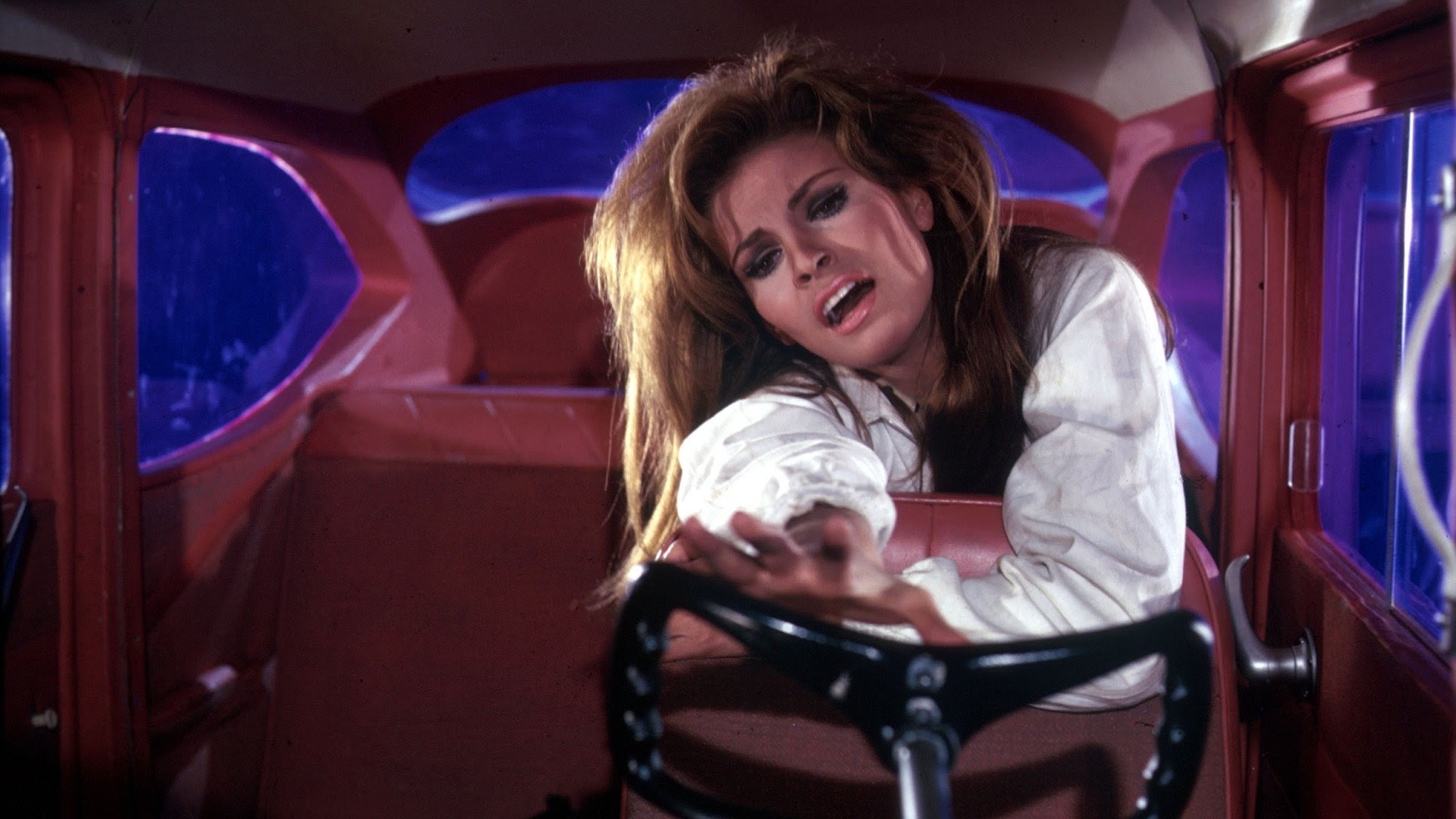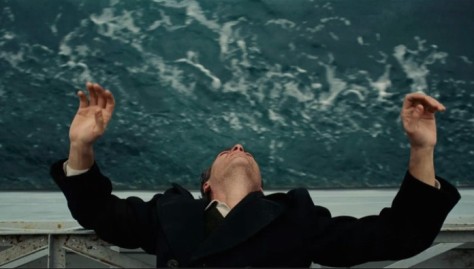By Dennis Hartley
(Originally posted on Digby’s Hullabaloo on February 18, 2023)
 Train in vein: Raquel Welch (September 5, 1940- February 15, 2023)
Train in vein: Raquel Welch (September 5, 1940- February 15, 2023)
In the canyons of your mind
I will wander through your brain
To the ventricles of your heart, my dear
I’m in love with you again
– from “Canyons of Your Mind,” by The Bonzo Dog Doo-Dah Band
Earlier this week, I was mindlessly scrolling through Twitter (as one does) and noticed that Fantastic Voyage was trending. Initially, I was puzzled as to why that nearly 60 year-old film was on the radar. Then I saw “Raquel Welch” trending, and thought “Uh-oh…another pop culture icon of my youth has diminished and gone into the West.”
There’s a 65% chance that I couldn’t tell you where I left my goddam keys, but I have vivid memories of attending a Saturday matinee showing of Fantastic Voyage at Theater #1 (Fort Wainwright, Alaska) and becoming mesmerized by the sight of Raquel Welch cavorting about the movie screen in a skin-tight scuba outfit for 2 hours.
Being only 10 in 1966, I could not articulate exactly what it was about this vision that captured my imagination, any more than I could explain the similar fascination I had for watching Diana Rigg cavort about the TV screen in a skin-tight leather outfit (on the odd occasion my parents would let me stay up to watch The Avengers).
Of course, Raquel Welch starred in a number of memorable films; Hannie Caulder, Kansas City Bomber, The Three Musketeers, The Four Musketeers, The Last of Shelia, Lady in Cement, Bedazzled, The Magic Christian, and One Million Years B.C. round off my top 10. But Fantastic Voyage holds a special place in the ventricles of my heart.
So in memoriam to Ms. Welch (and our first encounter) I thought I’d take time out to thank all the little people-in alphabetical order:

The Borrower Arrietty – Based on Mary Norton’s 1952 novel, The Borrowers, Hiromasa Yonebayashi’s enchanting 2010 anime follows the travails of a family of 4-inch tall people who live under the floorboards of a country home. Teenager Arrietty (voiced by Mirai Shida) and her parents survive by “borrowing” items from the humans who live upstairs; items that they won’t necessarily miss (a cube of sugar yields a year’s worth of sweetener for their tea).
The tricky part, of course, is absconding with the provisions without attracting attention. Once Arrietty is spotted by the young boy who lives in the house, life for her family becomes complicated. This is a lovely film, beautifully animated. The screenplay was adapted by Studio Ghibli’s master director, Hayao Miyazaki, with Keiko Niwa.

Darby O’Gill and the Little People – Sean Connery…in a film about leprechauns?! Stranger things have happened. Albert Sharpe gives a delightful performance as lead character Darby O’Gill in this 1959 fantasy from perennially family-friendly director Robert Stevenson (Mary Poppins, The Love Bug, The Absent-Minded Professor, That Darn Cat!).
Darby is a crusty yet benign b.s. artist who finds himself embroiled in the kind of tale no one would believe if he told them it were true-matching wits with the King of the Leprechauns (Jimmy O’Dea), who has offered to play matchmaker between Darby’s daughter (Janet Munro) and the strapping pre-Bond Connery.
The special effects hold up well (considering the limitations of the time). The scenes between Sharpe and O’Dea are amusing (“Careful what you say…I speak Gaelic too!”). Stevenson later directed another “little people” movie, The Gnome-Mobile, in 1967.

Fantastic Planet – Lest you begin to think that every film on this list is “family-friendly”, think again. I wouldn’t show this one to the kids (unless they’re the kids from Village of the Damned).
Director Rene Laloux’s imaginative 1973 animated fantasy (originally released as La planete sauvage) is about a race of mini-humans called Oms, who live on a distant planet and have been enslaved (or viewed and treated as dangerous pests) for generations by big, brainy, blue aliens called the Draags. We follow the saga of Terr, an Om adopted as a house pet by a Draag youngster.
Equal parts Spartacus, Planet of the Apes, and that night in the dorm you took mushrooms, it’s at once unnerving and mind-blowing.

Fantastic Voyage – This Cold War thriller/sci-fi/action hybrid starring Raquel Welch (poured into a body suit), could only have been concocted in the 1960s. A scientist from behind the Iron Curtain sustains a serious head injury while being “brought in from the cold” by the CIA. Now it’s up to a team of scientists to operate on the life-threatening blood clot…from inside the man’s body (thanks to a top-secret government project that enables humans to be miniaturized to the size of a blood cell). The catch is that the team can only be miniaturized for one hour max (tick…tick…tick).
Welch is joined in the world’s tiniest lil’ submarine by Steven Boyd, Donald Pleasance, Arthur Kennedy and William Redfield. Richard Fleisher directed, and the film picked up Oscars (for art/set direction and special effects). The film undoubtedly inspired Joe Dante’s 1987 sci-fi comedy, Innerspace. BTW, director Fleischer’s Uncle Dick directed the next film on my list (OK, I’ll say it: Small world…).

Gulliver’s Travels (1939) – “There’s a giant on the beach!” Filmmakers have been trying to get this one right for over 100 years (the earliest version was made in 1902, the most recent was 2010), but for me, Dick Fleischer’s 1939 animated musical remains the definitive movie adaptation of Jonathan Swift’s classic novel.
Clocking in at just a little over an hour, it’s the breezy tale of a sailor named Gulliver, who washes up on the shores of the fantastical land of Lilliput. At first, the tiny Lilliputians aren’t sure how they should react to this mysterious “giant”, but he proves to be a valuable asset in helping to resolve brewing tensions between them and their neighbors in the equally diminutive kingdom of Blefiscu. A visual and musical delight (and you’ve gotta love a pacifist hero).

Help! – Compared to its predecessor A Hard Day’s Night, this film vehicle for The Beatles is more fluffy. Ringo is chased by a religious cult who wish to offer him up as a human sacrifice; hilarity ensues. But still, it’s a lot of fun, if you’re in the proper mood for it. Luckily, the Beatles themselves exude enough goofy energy and effervescent charm to make up for the wafer-thin plot line.
There are a few good zingers in Marc Behm and Charles Wood’s screenplay; but the biggest delights come from the Beatles’ music, and director Richard Lester’s flair for visual inventiveness. Which brings me to the reason I included this film on my list…a vignette entitled “The Exciting Adventure of Paul on the Floor”, wherein Paul accidentally receives an overdose of a mad scientist’s “shrinking” serum. It’s a small (*ahem*) section of the film, but it’s memorable.

Honey, I Shrunk the Kids –Rick Moranis stars as a suburban absent-minded professor-type who invents a shrinking device. Before he has a chance to work out the bugs, a freak accident reduces his two kids and the next-door neighbor’s two kids into spoon-sized humans. Hilarity (and unexpected poignancy) ensues, as the four shrunken victims encounter assorted microcosmic terrors in the backyard while Dad frantically brainstorms a solution.
Special effects are imaginative and well-done. While this is Disney (the original working title was The Teenie Weenies), it’s not as twee as one might expect. This was the directorial debut for Joe Johnston, who would later make the outstanding family drama October Sky.

The Incredible Shrinking Man – Always remember, never mix your drinks. And, as we learn from Jack Arnold’s 1957 sci-fi classic, you should never mix radiation exposure with insecticide…because that will make you shrink, little by little, day by day. That’s what happens to Scott Carey (Grant Williams), much to the horror of his wife (Randy Stuart) and his stymied doctors.
Unique for its time in that it deals primarily with the emotional, rather than fantastical aspects of the hapless protagonist’s transformation. To be sure, the film has memorable set-pieces (particularly Scott’s chilling encounters with a spider and his own house cat), but there is more emphasis on how the dynamics of the couple’s relationship changes as Scott becomes more diminutive. The denouement presages the existential finale of The Quiet Earth.
In the fullness of time, some have gleaned sociopolitical subtext in Richard Matheson’s screenplay; or at least a subtle thumb in the eye of 1950s conformity. Matheson adapted from his novel. He also wrote the popular I Am Legend (adapted for the screen as The Last Man on Earth , The Omega Man and the eponymous 2007 film).

The Indian in the Cupboard – Veteran Muppeteer Frank Oz teamed up with E.T. screenwriter Melissa Mathison for this light fantasy about a boy and a tiny Native American warrior who lives in his cupboard. Omri (Hal Scardino) receives a small antique cupboard as a birthday gift. A friends gives him a plastic Indian play figure, which he puts in the cupboard. His mother (Lindsay Crouse) digs up a family heirloom key, which enables Omri to secure his new toy.
There’s something about the combo of cupboard, key and figurine that results in the appearance of a living, breathing, toy-sized human named Little Bear (played by Native-American rapper Litefoot), who has time-traveled from 1761 (don’t ask). Soon he has two equally diminutive companions, a cowboy (David Keith), and a bumbling WW I English soldier (Steve Coogan). The film occasionally lags, but its sweet, gentle tone and positive message (promoting tolerance) isn’t the worst thing you could share with the kids.

The Secret Adventures of Tom Thumb – This film, on the other hand, is probably about the worst “little people” fairy tale you could let the kids watch before bedtime. Closer to Eraserhead than, say, Pinocchio, this is one of those oddball films that nearly defies description.
English slum dwellers Ma and Pa Thumb (Deborah Collard and Nick Upton) are shocked when Ma gives birth to an infant you could fit in your pocket. Still, the proud parents soon find themselves showering their adorable (if freakish) little Tom with love and affection. Unfortunately, this happy family scenario is rudely interrupted when Tom is kidnapped by black-clad henchmen, who spirit him away to a truly creepy genetic lab. Tom’s secret adventures are only beginning.
Writer-director Dave Borthwick utilizes stop-motion techniques, combining actors with claymation to create an overall unsettling mood. It almost plays like a silent film; any “dialog” is unintelligible gibberish. All of the actors employ the same bizarrely mannered facial tics and line delivery, which are strangely reminiscent of Billy Bob Thornton’s character in Sling Blade. It’s weird, yet compelling.










































